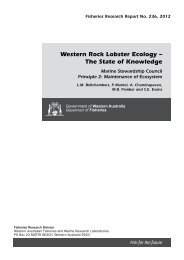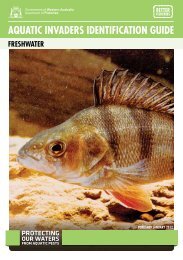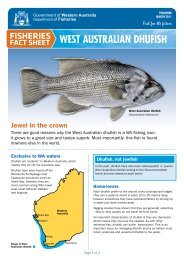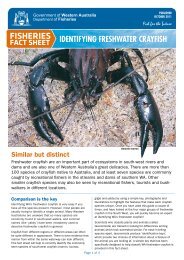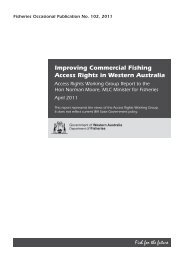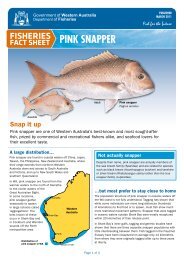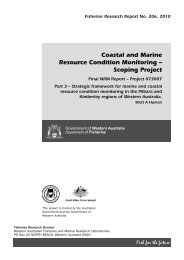Assessment of gonad staging systems and other ... - CiteSeerX
Assessment of gonad staging systems and other ... - CiteSeerX
Assessment of gonad staging systems and other ... - CiteSeerX
Create successful ePaper yourself
Turn your PDF publications into a flip-book with our unique Google optimized e-Paper software.
eproductive status will be overlayed. This will be indicated by the presence <strong>of</strong> migratorynucleus stage oocytes, hydrated oocytes <strong>and</strong> early/late stage POFs within the same <strong>gonad</strong>(the number <strong>of</strong> peaks depending on how many <strong>of</strong> these stages are present). Finally, at theend <strong>of</strong> the spawning season, the ovary enters the spent (F6) stage when residual vitellogenicoocytes are resorbed, marking a decrease in reproductive status back to that <strong>of</strong> the restingovary. Note that S. commerson ovaries in the spent (F6) stage also occur at <strong>other</strong> timesduring the annual cycle, indicating ovarian regression due to environmental, social orbiological factors.Further, note the shaded area in Figure 4, which indicates the period prior to reproductiveactivity when immature (F1) <strong>and</strong> mature resting (F2) ovaries may look quite similar <strong>and</strong> cantherefore be confused. In contrast, these two stages are quite distinct soon after thereproductive period whilst the mature ovary still retains evidence <strong>of</strong> previous spawning. Thisevidence may include a loose, relatively thin tunica, misshapen lamellae with loose stroma<strong>and</strong> few previtellogenic oocytes, large amounts <strong>of</strong> vascular <strong>and</strong> muscular tissue, atreticvitellogenic oocytes, <strong>and</strong> yellow-brown bodies. As time since last spawning increases, thisevidence is lost as the ovary tightens up <strong>and</strong> fills with previtellogenic oocytes. The bestevidence to distinguish a mature resting from an immature ovary immediately prior to thestart <strong>of</strong> the spawning season is the presence <strong>of</strong> yellow-brown bodies (melanomacrophagecentres). These are distinctive, yellow-brown coloured masses that are repositories for theend products <strong>of</strong> cell breakdown (Ferguson 1989), <strong>and</strong> provide evidence that a particularovary has undergone oocyte atresia <strong>and</strong> cell breakdown associated with spawning. Althoughreduced in size from those present in the ovary soon after spawning, the yellow-brownbodies present in mature ovaries prior to the spawning season are generally quite common.Immature ovaries may also contain yellow-brown bodies, but these are usually small <strong>and</strong>uncommon. The lamellae <strong>of</strong> mature ovaries also tend to be more branched than those in theimmature ovary.The F1a stage was used to identify ovaries that were probably immature but containedcortical alveoli stage oocytes. In some <strong>of</strong> these ovaries, the oocytes continue development asthe fish becomes sexually mature <strong>and</strong> spawns. However, given the number <strong>of</strong> small femaleswell below the estimated size at sexual maturity that had developing (but not developed)ovaries, it is likely that in some cases the cortical alveoli stage oocytes eventually atrophybecause the fish is not physiologically ready to spawn. Classifying these ovaries as F3 wouldfalsely inflate the number <strong>of</strong> mature fish in the samples as ovaries in this stage are generallyregarded as moving from the mature resting to the mature developed stage. Ovariesclassified as F1a were considered immature (F1) for analysis <strong>of</strong> size at maturity since theyare either still in this stage or are at the end <strong>of</strong> it. This stage also enables comparison <strong>of</strong> earlyovarian reproductive activity (as indicated by the appearance <strong>of</strong> cortical alveoli oocytes) inimmature <strong>and</strong> mature fish.12 Fish. Res. Rep. West. Aust.2001, 136, 1-32



